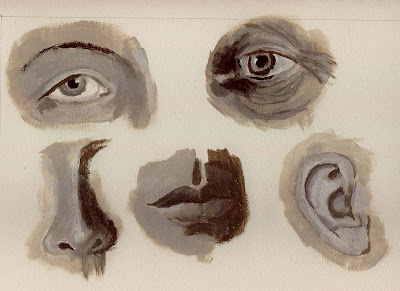 I've been frustrated by not knowing a thing about painting. Type of brush, quality, shape, size and material all make a difference. Then what do you do with each of them and really how do you do it. Then there is type of paint. I've come to find out that acrylic dries so fast that you can't blend colors or tones together to show contour, shading, or gradual change in skin tones. So, it is time to get some books from the library and do the exercises they suggest. Joseph Dawley published "Character Studies in Oil", 35 years ago. He shows wonderful character study portraits, very finely done on Masonite which appears to allow finer detail than canvas with its rough texture. Anyway, he shows how he goes about painting the parts of the face, hair, and then whole faces. The above are the first five exercises, top right is an old person's eye. He sets up 5 tones, in this case from white to pure raw umber, with 3 intermediate tones which he describes as white with 5%, 10% and 25% raw umber. I think mine were darker. Using these to lay in the various tonal and Shadow characteristics of the eye, mouth, ear etc. he then finishes up with blending to get contours and final touches of highlights and darks. He does his drawing with brushes, starting with very rough forms and refining as he goes. Of course he is using oil, and so he can wait until the last stage to blend. I found that I could get some blending here working in acrylic. If I lay the paint on thick and blend immediately. I think stiff bristle brushes are necessary for blending. There are tricks to be learned.
I've been frustrated by not knowing a thing about painting. Type of brush, quality, shape, size and material all make a difference. Then what do you do with each of them and really how do you do it. Then there is type of paint. I've come to find out that acrylic dries so fast that you can't blend colors or tones together to show contour, shading, or gradual change in skin tones. So, it is time to get some books from the library and do the exercises they suggest. Joseph Dawley published "Character Studies in Oil", 35 years ago. He shows wonderful character study portraits, very finely done on Masonite which appears to allow finer detail than canvas with its rough texture. Anyway, he shows how he goes about painting the parts of the face, hair, and then whole faces. The above are the first five exercises, top right is an old person's eye. He sets up 5 tones, in this case from white to pure raw umber, with 3 intermediate tones which he describes as white with 5%, 10% and 25% raw umber. I think mine were darker. Using these to lay in the various tonal and Shadow characteristics of the eye, mouth, ear etc. he then finishes up with blending to get contours and final touches of highlights and darks. He does his drawing with brushes, starting with very rough forms and refining as he goes. Of course he is using oil, and so he can wait until the last stage to blend. I found that I could get some blending here working in acrylic. If I lay the paint on thick and blend immediately. I think stiff bristle brushes are necessary for blending. There are tricks to be learned.I also read a book by a woman child portraitist. She demonstrates portraits in charcoal, sanguine, pastel, oil and watercolor of the same child. A real tour de force. Portraits in watercolor probably require the most skill. She said that pastel is the best medium for child portraits because it is so soft. Also, she never sprays (fixative) pastel (she does charcoal ans sanguine I think) because it dulls the color. Pastel must be framed under glass right away, but if so, it keeps its color best. This is great cause I can work in pastel, and paint is tough. Still it is fascinating and hugely challenging world. And the more I explore doing art, the more I come to appreciate art work, and the artists.












